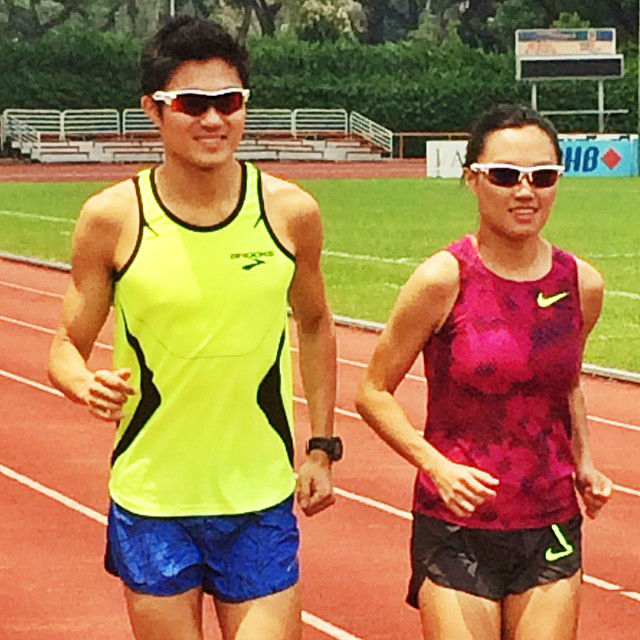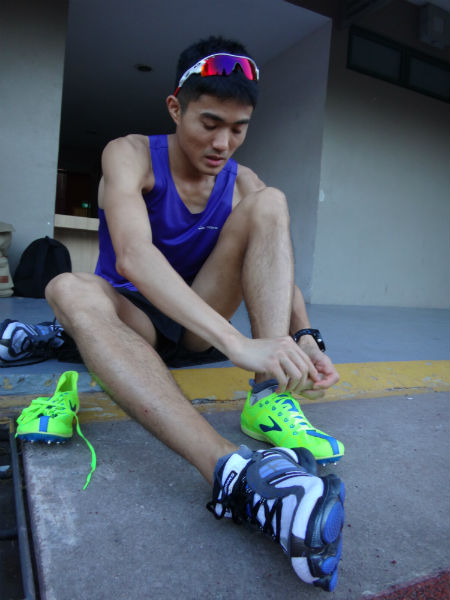26-year-old Mok Ying Ren is a well-known marathon runner in Singapore, with a 2013 Sea Games Marathon Gold Medal under his belt. Last year, the current Captain (Doctor) in the Singapore Army, also won the StanChart Marathon – Full Marathon, Men’s Local Category – completing the 42Km race in two hours 54 minutes and 17.90 seconds.
His younger sister, Mok Ying Rong, a 20-year-old physiotherapy student who graduates this year, has a stellar running record herself too, and has won a number of local races. These have included the Sundown Marathon – 21Km Women’s Category in May this year, and the POSB Passion Run – 10Km Women’s Category last week. In last year’s StanChart Marathon – Full Marathon, Women’s Local Category, she completed the 42Km race with a second place podium finish in a timing of three hours 19 minutes and 12 seconds.
I tapped on the Mok siblings’ medical and running expertise and asked them a few questions about running injuries. Here are tips that Mok Ying Ren and his younger sister have shared with this year’s StanChart Marathon participants – on how to prevent running injuries.
What do you think are the most common types of running related injuries?
Mok Ying Ren:
Overused injuries are the most common types. The other types such as traumatic injuries are much rarer unless the runner takes an acute fall.
Ying Rong:
Iliotibial Band Friction Syndrome (causing lateral knee pain), patellafemoral syndrome (pain or discomfort originating from the back of the knee caps) and shin splints
What are some of the main reasons why runners get injured?
Mok Ying Ren:
Most of the time we are overzealous in our training and get too carried away with training hard without sufficient recovery. This leads to an increased load on our muscles and bones such that they do not have sufficient time to adapt.
Ying Rong:
Muscular imbalances, chronic muscular tightness, improper running biomechanics
How do you feel that running injuries can be prevented?
Mok Ying Ren:
By being more patient in our training to allow adaptions to occur.
Ying Rong:
By going through regular physiotherapy biomechanical assessments to rule out any muscular imbalances or weaknesses can help to greatly reduce one’s injury risk. This is exactly what RunFree does for runners of all levels. (RunFree, which was founded by Mok Ying Rong, aims to empower individuals from all walks of life to run free from injuries and to remain injury free in the long run. For more information about RunFree, see the end of this article).
What are some tips that you can give, to nip a potential running injury in the bud, before it actually develops into a full-blown injury?
Mok Ying Ren:
It sounds easy, but really once there is some pain, it is important to stop straight away and do some cross training.
Ying Rong:
When you feel a pain that increases after or during a run, give yourself a break from running. And meanwhile, proceed to consult a physiotherapist. Do not run through the pain and hope that it will fade away.
You sometimes see runners still continue to run on, when they are clearly injured? What are your comments on this?
Mok Ying Ren:
It really depends on the goal of the runner. If he really wants to complete the marathon he is training for and retire from running, that could be a good idea. However, if he just started in the sport and have a long way ahead, it may be better to rest.
Ying Rong:
Runners are generally very determined in achieving their own personal goals. As such, I am really heartened to see people running through the pain simply because they want to achieve their goals ever so badly. However at the same time (through Runfree), I would like to help people understand their bodies better so that they will know how to rehab and condition their bodies more efficiently to achieve their goals (rather than simply trying to run through the pain to get to their goals).
When you sustain an injury during a run, how do you know when it is ok to push on and when it is better to stop running immediately?
Mok Ying Ren:
It depends on the state of the pain. Most overuse injuries get better after a warm up and during the run itself there is no pain, so sometimes we do not really know when we should stop. However, if during the run you sustain an injury such as a sprained ankle, you should stop as running through the injury can make it worse.
Ying Rong:
One way is by experience. After countless injuries, I have finally started to understand my body better and am better able to recognize too, when I can push on and when I should not.
Another way is to chart the progression of the pain. This may sound simple but often than not, a lot of times we do not actually notice the progression of the pain and only take note of it when the pain gets really intensed. If the pain seems to be increasing, it is best to stop and seek treatment immediately.
Do you think that kinesiology taping is effective when it comes to injuries?
Mok Ying Ren:
For certain injuries that involves movements of a joint it can help to realign the joint to reduce pain.
Ying Rong:
This allows for muscle activation, improves circulation and improves proprioception (or our overall sense of the positions of the different parts of our body). The evidence for improving proprioception is strongest. It allows us to be more observant of our joint and muscle movements. This ensures us to be more cautious of our movement patterns (such as our ankle placement when we land) and thus improves our biomechanics and reduce our injury risk.
How does doing cross training help with preventing running injuries?
Mok Ying Ren:
Cross training every few days reduces load on the body and yet allows the same cardiovascular training. This helps in prevent injuries. The best types of cross training are cycling, elliptical or deep water running.
Ying Rong:
Cross training allows the use of other muscles in different intensity and proportions. When we run, we tend to overwork a particular set of muscles and tend to work only in the sagittal plane of movement. (This is a vertical plane passing from anterior to posterior, dividing the body into left and right halves). But in cross training activities like swimming, we get the chance to work more in the other planes of movement such as the frontal and even the horizontal plane of movement. This allows a change of muscular activation, preventing the deconditioning of those muscles that are not primarily activated in running.
Give your comments on how taking rest days and getting enough sleep helps in preventing injuries.
Mok Ying Ren:
Rest days are important especially after days of hard workouts. Sleep helps our entire body to recovery as it also produces growth hormones that allows our muscles and bones to get stronger.
Ying Rong:
One can experiment with the frequency of rest days. Different people have different recovery rates. It would be good to keep a training diary to record one’s progress with their trainings, recovery rates and their bodies’ reactions to the workouts.
Having enough sleep allows muscle fibers to be repaired and allows the mind an opportunity to rejuvenate and refresh.
Any last words you would like to leave with SCMS participants, on running injuries?
Mok Ying Ren:
Have fun during the marathon. Most importantly, listen to your body,you know yourself best!
Ying Rong:
Run happy and run safe!
Visit RunFree (https://www.facebook.com/RunFreeSG) for more information on how to run injury free. Approach RunFree for individual and small group consultation regarding injury risk assessment and injury prevention now!
Ying Rong, tell us more about Runfree.
Ying Rong:
RunFree was founded by me. RunFree aims to empower individuals from all walks of life to run free from injuries and to remain injury free in the long run. We teach runners to understand their bodies better, to better appreciate the running motion and to understand the running biomechanics in greater depth. We teach individuals to use affordable and easily accessible tools like rolling pins, golf balls, tennis balls, towels, water bottles for rehab and strengthening.
Other Blog Posts
Training Tips for SCMS by Alex Ong and Anne Qi Hui





Leave a Comment